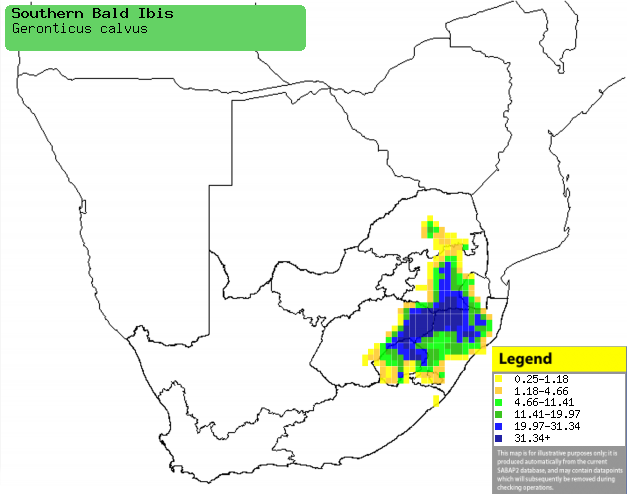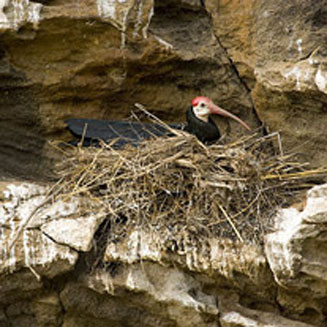|
Geronticus calvus (Southern
bald ibis)
Kalkoenibis [Afrikaans]; Umcwangele [Xhosa]; umXwagele
(generic term for ibis), uNkondlo [Zulu]; Lesuhla-ngeto, Mokhotlo [South Sotho];
Kaapse ibis [Dutch]; Ibis du Cap [French]; Glattnackenrapp [German]; Ibis-calvo
[Portuguese]
Life
> Eukaryotes >
Opisthokonta
> Metazoa (animals) >
Bilateria >
Deuterostomia > Chordata >
Craniata > Vertebrata (vertebrates) > Gnathostomata (jawed
vertebrates) > Teleostomi (teleost fish) > Osteichthyes (bony fish) > Class:
Sarcopterygii (lobe-finned
fish) > Stegocephalia (terrestrial
vertebrates) > Tetrapoda
(four-legged vertebrates) > Reptiliomorpha > Amniota >
Reptilia (reptiles) >
Romeriida > Diapsida > Archosauromorpha > Archosauria >
Dinosauria
(dinosaurs) > Saurischia > Theropoda (bipedal predatory dinosaurs) >
Coelurosauria > Maniraptora > Aves
(birds) > Order: Ciconiiformes
> Family: Threskiornithidae
Distribution and habitat
Endemic to the Great Escarpment, from the Limpopo Province
through Swaziland and Mpumalanga to eastern Free State, Lesotho and KwaZulu-Natal.
It generally prefers high-altitude treeless grassland and recently burnt,
ploughed or heavily grazed fields.
|
 |
|
Distribution of Southern bald ibis in southern Africa,
based on statistical smoothing of the records from first SA Bird Atlas
Project (©
Animal Demography unit, University of
Cape Town; smoothing by Birgit Erni and Francesca Little). Colours range
from dark blue (most common) through to yellow (least common).
See here for the latest distribution
from the SABAP2. |
Predators and parasites
Movements and migrations
Largely resident, although it sometimes
disperses after breeding in the period from August-December.
Food
It mainly eats insects, foraging in small flocks of usually
5-15, rarely up to 100 birds, probing the ground and snapping up prey. The following food items have been recorded
in its diet:
- Invertebrates
- insects
- earthworms
- snails
- Vertebrates
- frogs
- small mammals
- birds
- carrion (rarely)
Breeding
- Monogamous, although it rarely copulates with a second mate. It almost
invariably breeds in colonies of 2-72 pairs.
- The nest (see image below) is built by the female with material provided
by the male, consisting of a flimsy platform of branches and sticks, lined
with finer material and placed on a ledge or pothole on a cliff.
 |
|
|
Southern bald ibis at its nest, Wakkerstroom,
South Africa. [photo
Warwick Tarboton ©] |
|
- Egg-laying season is from July-January, peaking from August-September when
there is plenty of burnt grassland to forage on.
- It lays 1-3 eggs, which are incubated by both sexes for roughly 27-31
days.
- The chicks are fed by both parents by regurgitation, taking their first
flight at about 55 days old and becoming fully independent approximately five
days later.
Threats
Vulnerable or Threatened, largely due to
commercial afforestation, intensive agriculture, acid rain, open-cast mining and
human interference at breeding colonies; its world population is estimated to be
5000-10000 individuals.
References
-
Hockey PAR, Dean WRJ and Ryan PG 2005. Roberts
- Birds of southern Africa, VIIth ed. The Trustees of the John Voelcker
Bird Book Fund, Cape Town.
|
